
The Origin and Dynamics of Solar Magnetism (Space Sciences Series of ISSI, 32)
ISBN-13:
9781441902382
ISBN-10:
1441902384
Edition:
2009
Author:
S.K. Solanki, A. Balogh, M. J. Thompson, J.L. Culhane, Å. Nordlund, J.-P. Zahn
Publication date:
2009
Publisher:
Springer
Format:
Hardcover
436 pages
Category:
Astronomy
,
Astronomy & Space Science
,
Astrophysics
,
Physics
,
Geology
,
Earth Sciences
FREE US shipping
Book details
ISBN-13:
9781441902382
ISBN-10:
1441902384
Edition:
2009
Author:
S.K. Solanki, A. Balogh, M. J. Thompson, J.L. Culhane, Å. Nordlund, J.-P. Zahn
Publication date:
2009
Publisher:
Springer
Format:
Hardcover
436 pages
Category:
Astronomy
,
Astronomy & Space Science
,
Astrophysics
,
Physics
,
Geology
,
Earth Sciences
Summary
The Origin and Dynamics of Solar Magnetism (Space Sciences Series of ISSI, 32) (ISBN-13: 9781441902382 and ISBN-10: 1441902384), written by authors
S.K. Solanki, A. Balogh, M. J. Thompson, J.L. Culhane, Å. Nordlund, J.-P. Zahn, was published by Springer in 2009.
With an overall rating of 3.8 stars, it's a notable title among other
Astronomy
(Astronomy & Space Science, Astrophysics, Physics, Geology, Earth Sciences) books. You can easily purchase or rent The Origin and Dynamics of Solar Magnetism (Space Sciences Series of ISSI, 32) (Hardcover) from BooksRun,
along with many other new and used
Astronomy
books
and textbooks.
And, if you're looking to sell your copy, our current buyback offer is $0.3.
Description
Starting in 1995 numerical modeling of the Earth’s dynamo has ourished with remarkable success. Direct numerical simulation of convection-driven MHD- ow in a rotating spherical shell show magnetic elds that resemble the geomagnetic eld in many respects: they are dominated by the axial dipole of approximately the right strength, they show spatial power spectra similar to that of Earth, and the magnetic eld morphology and the temporal var- tion of the eld resembles that of the geomagnetic eld (Christensen and Wicht 2007). Some models show stochastic dipole reversals whose details agree with what has been inferred from paleomagnetic data (Glatzmaier and Roberts 1995; Kutzner and Christensen 2002; Wicht 2005). While these models represent direct numerical simulations of the fundamental MHD equations without parameterized induction effects, they do not match actual pla- tary conditions in a number of respects. Speci cally, they rotate too slowly, are much less turbulent, and use a viscosity and thermal diffusivity that is far too large in comparison to magnetic diffusivity. Because of these discrepancies, the success of geodynamo models may seem surprising. In order to better understand the extent to which the models are applicable to planetary dynamos, scaling laws that relate basic properties of the dynamo to the fundamental control parameters play an important role. In recent years rst attempts have been made to derive such scaling laws from a set of numerical simulations that span the accessible parameter space (Christensen and Tilgner 2004; Christensen and Aubert 2006).


We would LOVE it if you could help us and other readers by reviewing the book
Book review

Congratulations! We have received your book review.
{user}
{createdAt}
by {truncated_author}


